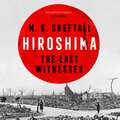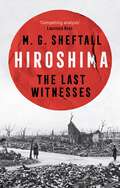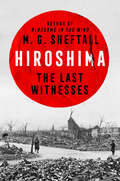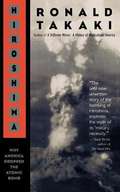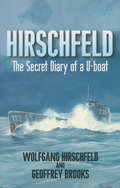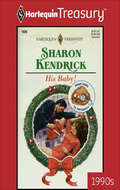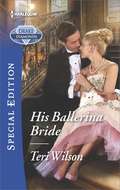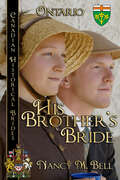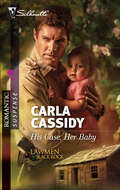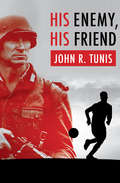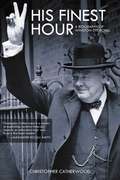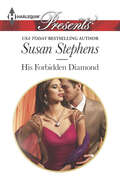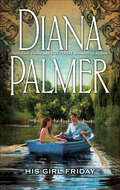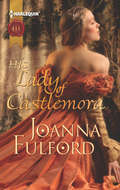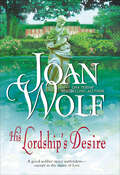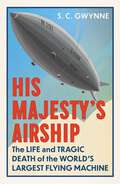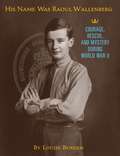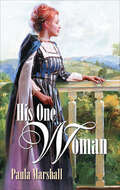- Table View
- List View
Hiroshima's Shadow: Writings on the Denial of History and the Smithsonian Controversy
by Kai Bird Lawrence LifschultzExamines the controversy around the use of the atomic bomb to end the war with Japan.
Hiroshima: The Last Witnesses
by M.G. SheftallThe stories of hibakusha - Japanese for atomic bomb survivors - lie at the heart of this compelling minute-by-minute account of 6 August 1945 - the day the world changed forever as the Enola Gay dropped its payload over Hiroshima, ushering in the nuclear age. These survivors and witnesses, now with an average age of over 90, are the last people alive who can still provide us with reliable and detailed testimony about life in Hiroshima before the bombings. In this heart-stopping account they relay what they experienced on the day the city was obliterated, and what it has been like to live with those memories and scars over the rest of their lives.M. G. Sheftall has spent years personally interviewing survivors who were just adolescents at the time but have lived well into their nineties, allowing him to construct portraits of what Hiroshima was like before the bomb, and how catastrophically its citizens' lives changed in the seconds, minutes, days, weeks, months and years afterwards. Fluent in spoken and written Japanese, his deep immersion in Japanese society has given him unprecedented access to the hibakusha in their waning years. Their trust in him is evident in the personal and traumatic depths they open up for him as he records their stories.The result is a deeply human history of an unfathomable tragedy, which continues to haunt the world today.
Hiroshima: The Last Witnesses
by M.G. SheftallThe stories of hibakusha - Japanese for atomic bomb survivors - lie at the heart of this compelling minute-by-minute account of 6 August 1945 - the day the world changed forever as the Enola Gay dropped its payload over Hiroshima, ushering in the nuclear age. These survivors and witnesses, now with an average age of over 90, are the last people alive who can still provide us with reliable and detailed testimony about life in Hiroshima before the bombings. In this heart-stopping account they relay what they experienced on the day the city was obliterated, and what it has been like to live with those memories and scars over the rest of their lives.M. G. Sheftall has spent years personally interviewing survivors who were just adolescents at the time but have lived well into their nineties, allowing him to construct portraits of what Hiroshima was like before the bomb, and how catastrophically its citizens' lives changed in the seconds, minutes, days, weeks, months and years afterwards. Fluent in spoken and written Japanese, his deep immersion in Japanese society has given him unprecedented access to the hibakusha in their waning years. Their trust in him is evident in the personal and traumatic depths they open up for him as he records their stories.The result is a deeply human history of an unfathomable tragedy, which continues to haunt the world today.
Hiroshima: The Last Witnesses (Embers #1)
by M. G. SheftallOne of Washington Post's 50 Notable Works of Nonfiction From 2024The first volume in a two-book series about each of the atomic bomb drops that ended the Pacific War based on years of irreplicable personal interviews with survivors to tell a story of devastation and resilience In this vividly rendered historical narrative, M. G. Sheftall layers the stories of hibakusha—the Japanese word for atomic bomb survivors—in harrowing detail, to give a minute-by-minute report of August 6, 1945, in the leadup and aftermath of the world-changing bombing mission of Paul Tibbets, Enola Gay, and Little Boy. These survivors and witnesses, who now have an average age over ninety years old, are quite literally the last people who can still provide us with reliable and detailed testimony about life in their cities before the bombings, tell us what they experienced on the day those cities were obliterated, and give us some appreciation of what it has entailed to live with those memories and scars during the subsequent seventy-plus years. Sheftall has spent years personally interviewing survivors who lived well into the twenty-first century, allowing him to construct portraits of what Hiroshima was like before the bomb, and how catastrophically its citizens&’ lives changed in the seconds, minutes, days, weeks, months, and years afterward. He stands out among historians due to his fluency in spoken and written Japanese, and his longtime immersion in Japanese society that has allowed him, a white American, the unheard-of access to these atomic bomb survivors in the waning years of their lives. Their trust in him is evident in the personal and traumatic depths they open up for him as he records their stories. Hiroshima should be required reading for the modern age. The personal accounts it contains will serve as cautionary tales about the horror and insanity of nuclear warfare, reminding them—it is hoped—that the world still lives with this danger at our doorstep.
Hiroshima: Why America Dropped the Atomic Bomb
by Ronald T. TakakiThe bombing of Hiroshima was one of the pivotal events of the twentieth century, yet this controversial question remains unresolved. At the time, General Dwight Eisenhower, General Douglas MacArthur, and chief of staff Admiral William Leahy all agreed that an atomic attack on Japanese cities was unnecessary. All of them believed that Japan had already been beaten and that the war would soon end. Was the bomb dropped to end the war more quickly? Or did it herald the start of the Cold War? In his probing new study, prizewinning historian Ronald Takaki explores these factors and more. He considers the cultural context of race - the ways in which stereotypes of the Japanese influenced public opinion and policymakers - and also probes the human dimension. Relying on top secret military reports, diaries, and personal letters, Takaki relates international policies to the individuals involved: Los Alamos director J. Robert Oppenheimer, Secretary of State James Byrnes, Secretary of War Henry L. Stimson, and others... but above all, Harry Truman.
Hirschfeld: The Secret Diary of a U-Boat
by Geoffrey Brooks Wolfgang HirschfeldWhilst there have been many memoirs written by U-boat commanders of the Second World War, a book such as this, based upon the diaries of a senior Petty Officer telegraphist, written in 'real time' is something very special. Wolfgang Hirschfeld, whose diaries Geoffrey Brooks has translated is a born story teller. The principal chapters describe his experiences during six war patrols in U-109, in which he served as the senior telegraphist. His is a tale which covers the whole kaleidescope of emotions shared by men at war—a story of immense courage and fortitude, of remarkable comradeship born of the dangers, frustrations and privations shared and of transitory moments of triumph. Throughout runs a vein of humour, without which resistance to stress would have been virtually impossible. We get to know one of Germany's great U-boat aces, 'Ajax' Bleichrodt, holder of the Knight's Cross of the Iron Cross with Oak Leaves and, in a special biographical appendix, learn how he finally cracked under the strain. The role of Admiral Karl Donitz, the dynamic commander of the U-boat service, so fascinatingly described by Hirschfeld, is of special interest—not least because even this dedicated Nazi had clearly realized by September, 1942, that the war was fast being lost. In 1944 Hirschfeld was promoted Warrant Officer and found himself on a large, schnorkel-equipped boat (U-234) heading for Japan with a load of high technology equipment and, in addition, a quantity of uranium ore. The possible significance of that uranium has been deeply researched by Geoffrey Brooks and is discussed in a second appendix.
His Baby!: His Majesty's Child An Accidental Birthright Majesty, Mistress... Missing Heir (From Here to Paternity #11)
by Sharon KendrickFROM HERE TO PATERNITYComing home for Christmas!Matthew Hamilton's baby daughter, Sophie, adores Daisy Blair. So when Sophie needs a babysitter while she and Matthew are staying with her grandmother over Christmas, he looks no further than Daisy. What Matthew doesn't know is that Daisy has been in love with him forever and that his troubles are just about to begin! Because Daisy decides she wants to be more than a substitute mom to Sophie, while Matthew just isn't ready to start playing happy families!FROM HERE TO PATERNITY-men who find their way to fatherhood by fair means, by foul, or even by default!
His Ballerina Bride (Drake Diamonds #1)
by Teri WilsonThe Ultimate Pas de Deux A Page Six Exclusive Report Debonair Artem Drake has had tongues wagging all over New York since he became surprise CEO of Drake Diamonds. This playboy hopes to bring new life to the storied old business before those rumored bad investments sink the family ship. He's even plucked an ambitious salesgirl out of the shadows to become the store's new star designer. But Ophelia Rose isn't the ingenue she seems. The swanlike beauty's hiding a past that glimmers as bright as a Drake diamond-she once graced the stage as a professional ballerina...until she was forced to take her final curtsy and hide from the limelight. Now can Artem bring her back to center stage? Or will their glittering future together wither under the secrets of the past?
His Best Friend's Baby (Midwives On-Call #6)
by Susan CarlislePregnant on his doorstep! Former army medic Ryan Matthews loves his work as a midwife-bringing life into the world helps him forget losing his best friend in Iraq. But when Ryan finds his friend's pregnant wife on his doorstep, his whole world is turned upside down... For Ryan, opening his door to Phoebe is one thing-but opening his heart is a whole different matter. Until one scorching, unforgettable kiss unleashes emotions he locked away long ago...and Ryan finds himself fighting against a love he's never dared to believe exists!
His Brother's Bride: Canadian Historical Brides (Canadian Historical Brides #2)
by Nancy M BellThe youngest child of the local doctor and evangelical preacher, Annie Baldwin was expected to work hard and not protest. Life on a pioneer farm was tough so neighbors helped each other. George Richardson the underage Doctor Bernardo Boy, orphaned and shipped to Canada a few years earlier, is loaned to the Baldwins to help bring in the hay. Younger brother Peter Richardson was placed with another neighbor, so the brothers stayed in touch with each other. The Great War brought a lot of changes to life even in the back woods of Ontario. In spite of the differences in their social standing, George and Annie fell in love. When George departed for France they had an understanding and he promised to return to her when the war was over. Like so many others, Annie waited and hoped, carrying on as best she could. Only time would tell if her dreams would come true. If you enjoyed the work of Rosie James you'll love His Brother's Bride.
His Case, Her Baby (Lawmen of Black Rock #1)
by Carla Cassidy"The crib is empty."Peyton Wilkerson's world is shattered when her baby is taken from her very own home. Distraught, she finds comfort—and a growing attraction—in Sheriff Tom Grayson's arms. But knocking down the wall that Tom has erected around his heart will be tough….Tom knows the heartbreak of losing a child. He aches for Peyton, but refuses to give in to desires he thought long dead. When her life is threatened, Tom discovers that resistance is futile—he'd move mountains to keep mother and baby safe.
His Christmas Guardian (Runaway Ranch #4)
by Cindy DeesTrained to be enemies...Do they dare become lovers?CIA Agent Alex Creed&’s mission is to take down a deadly criminal before Christmas…and only Nick Kane stands in his way. The black ops agent claims he's after the same target and that working together is the best plan. Never before has Alex been so attracted to someone he shouldn&’t trust. Especially knowing Nick has a bit of a death wish, while Alex envisions a future together... From Harlequin Romantic Suspense: Danger. Passion. Drama.Feel the excitement in these uplifting romances, part of the Runaway Ranch series:Book 1: Navy SEAL's Deadly SecretBook 2: The Cowboy's Deadly ReunionBook 3: Her SEAL BodyguardBook 4: His Christmas Guardian
His Enemy, His Friend
by John R. TunisWhen a German war-criminal-turned-soccer-star comes to play a match in post-war France, old wounds are reopenedConvicted in 1944 of war crimes committed in the occupied village of Nogent-Plage, former German Sergeant Hans von Kleinschrodt is sentenced to ten years&’ hard labor. By 1964, he has become the captain and goalie of the German champion soccer team—but he remains infamous throughout France, despite his insistence that he alone defied orders to slaughter the villagers when the Allied Forces arrived. When the German team must face the French champions in Rouen, the very city where Hans was sentenced twenty years earlier, the stage is set for a grudge match—and revenge.
His Father's Son: The Life of General Ted Roosevelt, Jr.
by Tim BradyThe story of Theodore Roosevelt, Jr., a fortunate son who proved himself on the battlefields of two world wars.General Omar Bradley said of him, “I have never known a braver man or a more devoted soldier.” But for much of his life, Theodore Roosevelt’s son Ted seemed born to live in his father’s shadow. With the same wide smile, winning charm, and vigorous demeanor, Ted possessed limitless potential, with even the White House within his reach. In the First World War, Ted braved gunfire and gas attacks in France to lead his unit into battle. Yet even after returning home a hero, he was unable to meet the expectations of a public that wanted a man just like his father. A diplomat, writer, and man of great adventure, Ted remained frustrated by his lack of success in the world of politics, witnessing instead the rise of his cousin, Franklin, to the office that had once seemed his for the taking.Then, with World War II looming, Ted reenlisted. In his mid-fifties with a gimpy leg and a heart condition, he was well past his prime, but his insistence to be in the thick of combat proved a vital asset. Paired with the irascible Terry de la Mesa Allen Sr., Ted soon distinguished himself as a front-line general in a campaign that often brought him into conflict with another hard fighter, George Patton. On D-Day, Ted became the oldest soldier and the only general in the Allied forces to storm the beach in the first wave, hobbling across the sand with his cane in one hand and a pistol in the other. His valor and leadership on Utah Beach became the stuff of legends—and earned him the Medal of Honor.His Father's Son delves into the life of a man as courageous, colorful, and unwavering as any of the Roosevelt clan, and offers up a definitive portrait of one of America’s greatest military heroes.INCLUDES PHOTOSFrom the Hardcover edition.
His Finest Hour: A Biography of Winston Churchill (Brief History Ser.)
by Christopher CatherwoodWho was Winston Churchill? Even fifty years after his death, he is one of the most iconic figures in British history. As a young man he was a maverick journalist; his many positions in politics before 1940 marked him as a courageous but foolhardy man. Yet it is Churchill’s record in war, which has recently been questioned, that confirms his genius as a military commander and national leader—someone who understood the dangers of Nazi Germany before 1939 and someone uniquely capable to lead the empire through the turmoil of the Second World War. Christopher Catherwood argues that it was Churchill’s stand in 1940-41 that saved Britain and that only he was able to bring together the allies that eventually defeated Hitler in 1945. Catherwood has produced a challenging yet lively reassessment of the life and career of Winston Churchill, lion of British history and flawed hero.
His Forbidden Diamond: An Emotional and Sensual Romance (The Skavanga Diamonds #3261)
by Susan StephensThe only woman he can't have... Former soldier and diamond dynasty heir Tyr Skavanga has finally returned to the cold north. Haunted by the terrors of war, he’s cut himself off and hardened his heart. But now one person has managed to defy his defenses, and she’s the last person he expected....is the only woman he wants! The exotically beautiful, innocent Princess Jasmina of Kareshi is strictly off-limits. Like Tyr, she has a reputation to protect, but denying their electrifying connection could prove to be the toughest challenge they have ever faced....
His Girl Friday
by Diana PalmerA secretary can’t resist her roguish boss in this classic workplace romance from a New York Times–bestselling author.There has only ever been one man for young Danetta Marist . . . but he’s the one she can never have. That’s gruff, handsome boss Cabe Ritter, whose mere glance makes her spine tingle and her heart race. And then there was that heart-stopping kiss in his office. But Danetta believes in marriage and happily-ever-afters. And everyone knows Cabe is a terrible womanizer . . . Deep down, Cabe is no playboy. Long ago, he put up a facade to protect himself from any woman—like his alluring secretary—who wanted a commitment from him. Cabe knows that young, fresh and deliciously tempting Danetta has a lot to learn about love. But now that he has held her in his arms once, he decides that he’ll be the man to teach her . . . for the rest of their lives.First published in 1989.
His Lady of Castlemora
by Joanna FulfordThe Betrothal BargainThe infamous Lord Ban has lost all in the Northumbrian conflict, and now this battle-hardened warrior must turn his thoughts to producing an heir. But only the very desperate would align her fate with such a man....Almost broken by the violent ravings of her first husband, the recently widowed but ever beautiful Lady Isabelle is left with no dowry and no hope for the future. Believed to be barren, she is forced into a secret betrothal to the powerful Lord. On one condition-she must be with child before the wedding vows are spoken....
His Last Breath (Reapers Strike Force #1)
by S. M. ButlerThe Reapers aren't exactly what they seem. They're the most elite of the world's fighters--but all they have in common is that their countries and their families can never know that they exist. Christopher Hardy has spent the last two years in self-imposed exile with a team he built from the ground up. A former SEAL, he was medically discharged after a near-death experience. But a brand-new procedure made him whole again and now his mission is to save the world or die trying. There's no room in there for love, not to mention it's against the rules. Abigail Lewis hasn't seen Chris since the day he rescued her five years ago. He's changed, grown darker and more dangerous than she remembers, but somehow that just seems to make him even sexier. But Chris is a high-risk heartache waiting to happen, and she's got bigger problems to worry about, like not getting murdered. Every moment they spend together becomes more and more incendiary, both for their lives and their hearts. Trust doesn't come easy and secrets have a way of getting out when you least expect it.
His Last Defense
by Karen RockSemper Paratus. Always ready. Years ago, Coast Guard rescue swimmer Dylan Holt left Kodiak, Alaska, with his heart in pieces. He thought Nolee Arnauyq and her mouthwatering curves were behind him-until he's sent to rescue the crew of a capsizing boat...including Nolee. And Dylan is definitely not ready for the too-familiar way his body aches at seeing her again. Nolee's always gone after what she wanted, and to hell with the risks. Now she's a rookie ship captain taking on the deadly waters of the Bering Sea. But out on these treacherous waters, there's no way to avoid the sizzling sexual tension between them-or the dangerous pull of emotions that could leave both their hearts lost at sea...
His Lordship's Desire
by Joan WolfNapoleon's troops stand defeated and Wellington's Spanish campaign is over. Now a dedicated British soldier enters a very different hind of war: a battle for the woman he loves...The eldest son of the Earl of Standish and heir to his late father's holdings, Alexander Devize is summoned home to his duties in England. Waiting for him, he believes, is Diana Sherwood, the irrepressible beauty with whom he shared an unforgettable night of passion, a young woman he fully intends to marry. But Diana, lovelier and more headstrong than ever, has other intentions.A soldier's daughter, Diana refuses to suffer the harsh world of being a soldier's wife and plans instead her coming out in London, ignoring the memories of wild and reckless Alex. Convinced she's found the proper, stable gentleman in Robert Welbourne, she pursues her course, unaware of a treachery building around her-or of the unwavering devotion of a soldier willing to fight for all he's worth in a battle he must not lose.
His Majesty's Airship: The Life and Tragic Death of the World's Largest Flying Machine
by S.C. GwynneWhen the R101 first took to the skies, she was the largest aircraft ever to fly. What followed was a tragic finale to a tale of human folly on a grand scale. 'I loved every page of this book.' THE TIMES, BEST HISTORY BOOKS OF 2023 In 1929, the R101 was the largest object ever to take to the air. It was meant to dazzle the world with cutting-edge technology and awesome size. Better than a plane, more luxurious than an ocean liner, the R101 would connect the furthest reaches of the British Empire, tying together far-flung dominions at a time when imperial bonds were fraying. It was, however, not to be. The spectacular crash of the British airship R101 in 1930 changed the world of aviation forever. Most have heard of the fiery crash of the Hindenburg, a German ship that went down in New Jersey seven years later. But the story of R101 and its forty-eight victims has largely been forgotten. His Majesty&’s Airship recounts the epic narrative of the ill-fated airship and her eccentric champion, Christopher Thomson. S. C. Gwynne brings to life a lost world of aviators driven by ambition, and killed by hubris.
His Name Was Raoul Wallenberg
by Louise BordenThis book is an amazing and inspirational World War II story about how one man saved the lives of many.
His One Woman (The Dilhorne Dynasty #3)
by Paula MarshallCivil war in a nation...and in a family!Jack Dilhorne was in Washington, D.C., on business just as war was being declared between the North and South. It was not the best of times to meet someone as intriguing as Marietta Hope.Marietta’s reputation preceded her: Jack expected her to be an embittered old maid. He was delightfully surprised to find her a bright, witty and goodlooking woman. But as Jack and Marietta grew closer their love came under threat from war...and from an enemy much closer to home!
His Pregnant Christmas Bride
by Olivia GatesCan a pregnant bride heal this tycoon's tormented past? Only from USA TODAY bestselling author Olivia Gates! Russian billionaire Ivan Konstantinov spent decades struggling with the treachery that almost destroyed him. But when Anastasia Shepherd, the only woman he's ever loved, suffers a near-fatal injury, he risks everything-even exposure to his betrayers-to save her. He intends only to heal her then walk away again, but their explosive passion can't be denied. Then she gives him the ultimate Christmas gift: she's expecting his child. Will the promise of a holiday wedding and a perfect future erase the scars of Ivan's past...or will darker secrets ruin all they hold dear?

